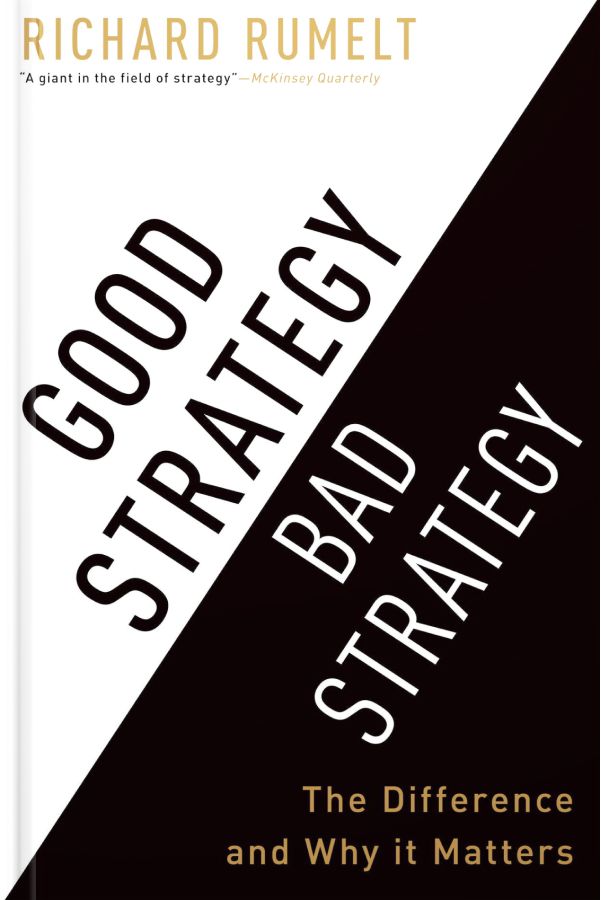
Good Strategy Bad Strategy by Richard Rumelt
1/ Let's talk strategy.
In this thread, I'll share with you the primary lessons from Richard Rumelt's book "Good Strategy / Bad Strategy."
If you lead strategy or product and haven't read Rumelt's book, this thread will be well worth your time.
2/ The big difference between "good" and "bad" strategy.
Good strategy takes many forms, but always includes at least 3 components:
• A diagnosis of the challenge
• A guiding policy to deal with the challenge
• A set of actions to enact the guiding policy
3/ Bad strategy is not simply the absence of good strategy.
Bad Strategy tends to skip over pesky details such as problems.
It ignores the power of choice and focus, trying instead to accommodate a multitude of conflicting demands and interests.
4/ Good strategy is unexpected.
The first natural advantage of good strategy arises because other organizations often don't have one.
And because they don't expect you to have one, either.
5/ Bad strategy usually comes with one or more of four major hallmarks
• Fluff
• Failure to face the challenge
• Mistaking goals for strategy
• Bad strategic objectives
6/ Why so much bad strategy?
Not miscalculation, bad strategy is the active avoidance of the hard work of crafting a good strategy.
Strategy involves focus and, therefor, choice. And choice means setting aside some goals in favor of others.
This is both painful and difficult.
7/ The antidote to bad strategy is the strategic kernel which contains:
• A diagnosis
• A guiding policy
• A set of coherent actions
These are important so let's look at them one at a time.
8/ Diagnosis.
Clear diagnosis is the foundation of any good strategy. It's also frequently missed.
The diagnosis provides perspective and should replace the overwhelming complexity of reality with a simpler story, a story that calls attention to what's most important.
9/ Guiding Policy.
The guiding policy outlines a plan for overcoming the obstacles found in the diagnosis.
Many people use the term "strategy" for what we are calling a "guiding policy."
A good policy leverages advantage to tackle the obstacles identified in the diagnosis.
10/ Coherent Action.
Many people call the guiding policy "the strategy" and stop there.
This is a mistake.
Strategy is about action, about doing something.
To have punch, actions should coordinate and build upon one another, focusing organizational energy.
11/ Let's pause for a second to recap:
We now know what to look for to diagnose bad strategy.
We also know the three elements of every good strategy.
Now let's turn our attention to some practical nuts and bolts.
What are some of the sources of power used in good strategies?
12/ Using Leverage
A good strategy draws power from focusing minds, energy, and action.
That focus, channeled at the right moment onto a pivotal objective, can produce a cascade of favorable outcomes.
This is leverage.
13/ Proximate Objectives
One of a leader's most powerful tools is the creation of a good proximate objective—one that is close enough at hand to be feasible.
A Proximate objective names a target that the organization can reasonably be expected to hit, even overwhelm.
14/ Chain-Link Systems
The performance of a chain-link system is limited by its weakest subunit, or "link."
When there is a weak link, a chain is not made stronger by strengthening the other links.
The excellence of a well-managed chain-link system is hard to replicate.
15/ Using Design
It's useful to think of strategy as a design problem because designers think in terms of mutual adjustment.
No problem gets solved in a vacuum and there are high gains to getting subtle combinations just right.
16/ Focus
Simply focusing on a smaller set of problems to solve is a source of power. Because most companies don't focus.
This one is simple, not easy.
17/ One way to find advantage is to exploit a wave of change.
Such waves are largely exogenous, resulting from shifts and advances in technology, cost, competition, politics, and buyer perceptions.
Most high growth businesses find a wave to ride.
18/ These waves are like wind in a racing boat's sails.
They provide raw, sometimes turbulent, power.
Finding new waves always requires getting into the gritty details. To make good bets on how a wave of change will play out you must know enough to question the experts.
19/ As change starts, you must be able to dig beneath that surface and discover the fundamental forces at work.
Leaders who stay "above the details" may do well in stable times, but riding a wave of change requires an intimate feel for its origins and dynamics.
20/ Once advantage has been identified, attention turns to maximizing that advantage.
This again requires focus: Focus on strengths and avoidance of weaknesses.
You must press where you have advantages and side-step situations in which you do not.
21/ You must also manage against inertia and entropy.
An organization's greatest challenge may not be external threats or opportunities, but instead the effects of entropy and inertia.
Let's finish up with a few thoughts on how you personally might actually do the work of strategy.
22/ Good Strategy is more science than art.
Good strategy is built on functional knowledge about what works, what doesn't and why. It's ultimately a hypothesis about what will work.
It requires logic and work, which anyone can do.
23/ Humans aren't nearly as rational or logical as we think we are.
So the work of strategy quickly becomes managing your personal emotions, fears, and irrationalities.
The trick is to choose how you approach each problem and guide your own thinking.




